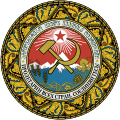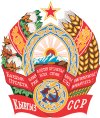| |||||||||||||||||||||||||||||||||||||||||||||||||||||||||||||||||||||||||||
| |||||||||||||||||||||||||||||||||||||||||||||||||||||||||||||||||||||||||||
In June 1938, elections took place in the Union of Soviet Socialist Republics (USSR) for the Supreme Soviets of its 11 constituent republics. [1] These elections were held following the adoption of the 1936 Constitution of the Soviet Union, which established a division of government branches into the Executive Council of People's Commissars of the Soviet Union and Legislative Supreme Soviet of the Soviet Union. [2] Consequently, the constitutions of the union republics were amended in 1937 to reflect this separation of powers, leading to the institutionalization of parliamentary structures. The elections were conducted for each of the Supreme Soviets of the USSR's constituent republics. According to Soviet law, approximately 5,100,000 individuals out of a total eligible adult voting population of 93,411,000 were disenfranchised due to various reasons. This marked the first instance of direct elections to these parliamentary bodies, signifying a significant shift in the political landscape of the USSR. [1] [3]
Certain individuals ran and were elected simultaneously in several union republics among which were Joseph Stalin, Kliment Voroshilov and others.
| Union Republic | Election date | Election name | Results |
|---|---|---|---|
| 24 June 1938 | 1938 Azerbaijani Supreme Soviet election | 310 / 310 | |
| 1938 Armenian Supreme Soviet election | 340 / 340 | ||
| 1938 Byelorussian Supreme Soviet election | 273 / 273 | ||
| 12 June 1938 | 1938 Georgian Supreme Soviet election | 237 / 237 | |
| 24 June 1938 | 1938 Kazakh Supreme Soviet election | 300 / 300 | |
| 24 June 1938 | 1938 Kirghiz Supreme Soviet election | 284 / 284 | |
| 26 June 1938 | 1938 Russian Supreme Soviet election | 568 / 727 | |
| 1938 Tajik Supreme Soviet election | Composition unknown | ||
| 1938 Turkmen Supreme Soviet election | Composition unknown | ||
| 1938 Uzbek Supreme Soviet election | Composition unknown | ||
| 26 June 1938 | 1938 Ukrainian Supreme Soviet election | 222 / 304 |


















